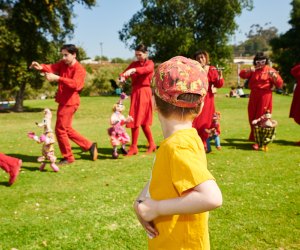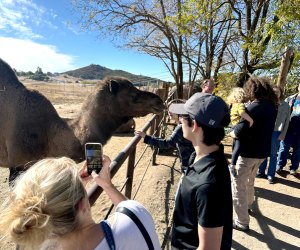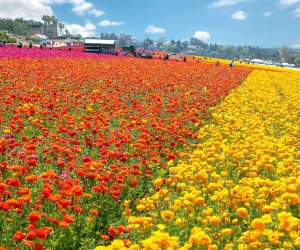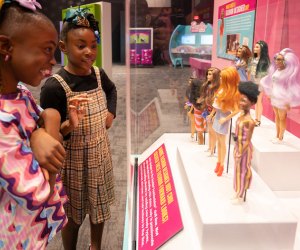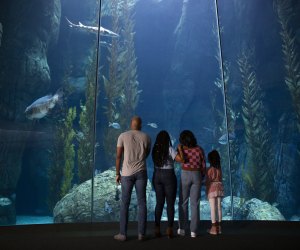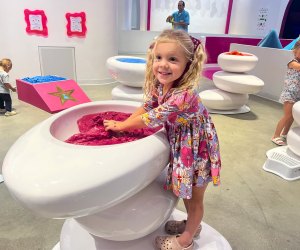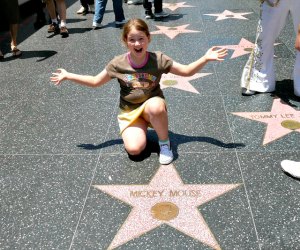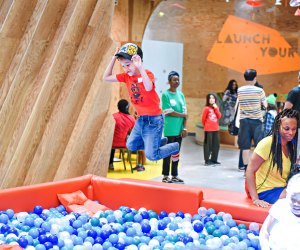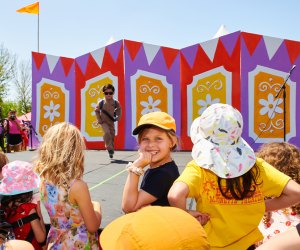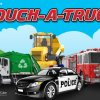The La Brea Tar Pits and Page Museum: Have a Historic Visit with Kids
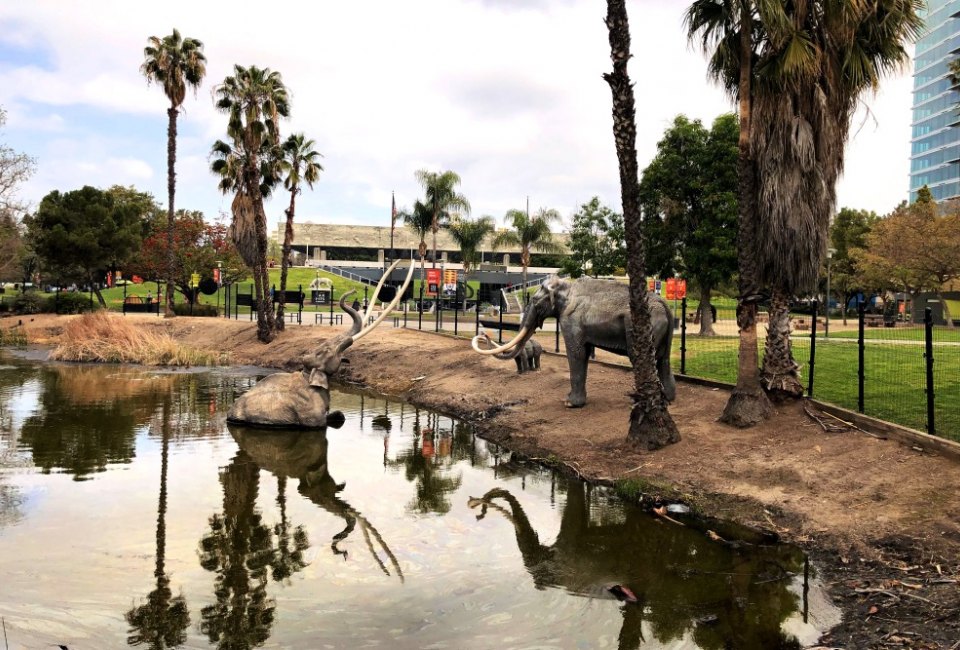
Exploring the La Brea Tar Pits is one of the best free things to do in Los Angeles with kids of all ages. But did you know that there's also an incredible museum just a few yards from the famous tar lake? The Page Museum at the La Brea Tar Pits gives an inside look at the city's prehistoric past and explains why that sticky black tar is seeping up all over the Miracle Mile. With a small footprint compared to the Natural History Museum or California Science Center, the Page Museum is easy to explore in a day—in fact, you'll have plenty of time to check out other sites along LA's "Museum Row," like the brand new Academy Museum.
Here's a detailed look at highlights of the La Brea Tar Pits and Page Museum, plus tips on where to eat, where to park, and what to explore in the area.
OUR LATEST VIDEOS
Tar bubbles up throughout the grounds. Photo courtesy of La Brea Tar Pits and Museum via Facebook
Exploring the La Brea Tar Pits with Kids
While the first thing kids head for at the Tar Pits is the famous tar lake and the mammoths that are stuck there, there are many other things to explore at the tar pits. One of my favorite tips is to bring kids in old play clothes that you don't mind ruining and let them grab sticks and poke in the tar that bubbles up throughout the park. While it's hard to clean, the tar provides a hands-on lesson in science and history that really sticks with kids (no pun intended).
On the grounds there are also several active excavation sites, and each of the digs has a different story to tell. These are our favorite places in the park to learn more about Los Angeles' prehistoric past.
Pit 91
Pit 91 began its life as a pool of sticky asphalt, trapping animals that were unfortunate enough to get too close. Paleontologists began digging the site in 1915, making it one of the longest-running urban excavation sites in the world. Early excavations uncovered the remains of sloths and saber-toothed cats, with later explorations nearly doubling the species of plants and animals found at the La Brea Tar Pits.
Please note that the Viewing Station at Pit 91 is currently closed, but you can still see where the scientists work.
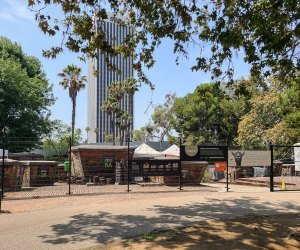
Project 23 shows exactly where the fossils of a mammoth skeleton were found.
Project 23
The history of this fossil deposit is a meeting of prehistory and modern development. Project 23 was discovered in 2006 when LACMA began work on a new underground parking garage. During the construction period, 16 new fossil deposits were discovered, with the highlight being an adult mammoth skeleton. Project 23 is unique among the digs at the tar pits because scientists wanted to save the fossils without holding up the construction of the garage, and used scientific ingenuity to come up with an "outside the box" solution (you'll understand the pun when you visit).

Poor mammoth! Photo courtesy of Google Images
Lake Pit
With its recreation of a mammoth being trapped in tar and visibility from Wilshire Blvd, the Lake Pit is easily the most iconic sight at the La Brea Tar Pits. This lake contains pits 17, 50, and the Academy Pit and was actually created in the late 1800s, a remnant of former asphalt mining operations. The reason the lake is so stinky is that there's an underground oil field deep beneath the water's surface. As you observe the lake, you'll notice big bubbles coming to the surface and popping—there's nothing better than the look on a toddler's face when a real whopper of a bubble pops. To make older kids giggle, let them know that the bubbles are actually escaping pockets of methane. Those bubbles are lake farts!
Pleistocene Garden
The Pleistocene Garden was created by the museum to give visitors an idea of the kinds of plants that grew in prehistoric Southern California. Believe it or not, scientists believe the climate in Los Angeles 50,000 years ago was colder and wetter—a lot more like that of the Monterey Peninsula. The plants in this garden were based on the discoveries from Pit 91.
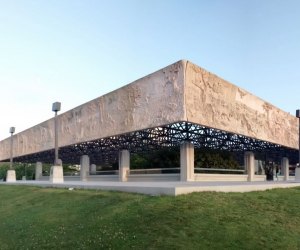
The Page Museum sits at the top of one a great grassy hills kids can roll down! Photo by Gunnar Klack via Wikimedia Commons
The La Brea Tar Pits Museum: The Page Museum
Lots of people visit the Tar Pits but skip the Page Museum, and that's a mistake. Unlike other museums, where the exhibits are housed in separate rooms or on different levels, the Page Museum has an open layout that makes it easy to navigate. As you make your way through the museum, interpretive exhibits showcase the prehistoric wildlife that called the Los Angeles basin home thousands of years ago, explain the formation of tar pits, and give a detailed explanation of how the paleontologists excavate fossils from the pits. If your child is a future paleontologist, be sure to stop at the Fossil Lab where real scientists sort fossils that were excavated just a few yards away at the only Ice Age fossil site that's being actively excavated in the heart of a major city.

Kids can explore the Fossil Lab with real scientists. Photo courtesy of La Brea Tar Pits and Museum via Facebook
Most natural history museums seem to put all the focus on dinosaurs—what's great about the Page is that all of its skeletons come from Ice Age creatures. There are dioramas and skeletal displays of animals like saber-tooth cats, dire wolves, giant sloths, and North American camels. Yes, camels used to roam around Los Angeles! The biggest draw, of course, is the jaw-dropping mastodon and mammoth fossils, and it's no surprise much of the museum's real estate is dedicated to these impressive, majestic creatures.

See the skeletons up close and personal. Photo courtesy of La Brea Tar Pits and Museum, Facebook
With over 400 skulls, it's almost impossible to miss the Dire Wolf Wall, and you wouldn't want to. Be sure to find the baby saber-tooth tiger puppet that was created by Jim Henson's Creature Shop, though its realism may equally intrigue and terrify your kids. There are lots of interactive exhibits that my kids loved, like the contraption giving you an idea of what it's like to be hopelessly stuck in a tar pit, the station that allows kids to assist a juvenile mastodon as it grows tusks, and the Rock'em Sock'em Robots-style station where kids can simulate a mammoth fight.

The Dire Wolf Wall is impressive to kids and adults alike.
Another highlight of the Page Museum is its 3D theater, which is currently showing Titans of the Ice Age 3D. Tickets for the theater are not included in general admission and cost $6 per person (NHM members get free admission).

Kids can see what it looks like when new fossils are discovered.
Food and Drinks near the La Brea Tar Pits
The Page Museum is very small and doesn't have a cafe, but there are plenty of kid-friendly dining options just steps away along Wilshire Blvd. Counter Burger is across the street, while Ray's and Stark Bar at LACMA is a short walk away and offers a bit more sophisticated fare for the adults (plus cocktails!) and a kids' menu with cheese pizza, chicken tenders, and more. Around lunchtime, food trucks park across the street and are a perfect representation of the city's cultural diversity. Los Angeles gets a bad rap for lacking great urban parks but Hancock Park is a true gem and a great place for a picnic—just don't put your picnic blanket near those spots where tar bubbles up out of the grass! The Original Farmers Market is just a short drive away and a great place to grab takeout to bring to the park.
Know Before You Go
Strollers
All exhibits at the Page Museum are stroller accessible, including the outdoor exhibits.
Changing Tables and Family Restrooms
All bathrooms have changing tables and there is a family restroom available.
Parking and Metro
Compared with a lot of the other museums in LA, parking at the La Brea Tar Pits is very easy. There's a dedicated surface lot off of Curson Ave. north of Wilshire with a $15 flat rate. Just remember that you cannot park along Wilshire Blvd. on weekdays between the hours of 7-9am and 4-7pm because your car will be ticketed and towed, even if you're parked at a meter. The only current public transportation option is the 20 and 720 Rapid bus along Wilshire Blvd., but we're eagerly awaiting the arrival of the Purple Line extension, which is slated to open in 2024 with a stop at Wilshire and Fairfax.

While everyone loves walking around the Lake Pit, the Page Museum is worth the price of admission.
Admission
General admission tickets are $15 per person for non-members and it's best to purchase advance tickets online. Like the Natural History Museum, Los Angeles County residents get free admission to the Page Museum from 3-5pm. Memberships to the Natural History Museums of Los Angeles County start at $149 for a family membership with several more expensive options for museum enthusiasts. Membership includes free admission to Natural History Museum, La Brea Tar Pits, and the William S. Hart Museum and other perks like a 10% discount at the museum cafe and gift stores.
Gift Shop
The Page Museum has a small gift shop with reference books, toys, and other collectibles.
While You're Here: Surrounding Attractions
The Tar Pits are located along a stretch of Wilshire Blvd. that's known for its museums like LACMA (while it's mostly closed, the Metropolis II exhibit that entrances kids is still running), the Petersen Automotive Museum, Craft Contemporary, and the area's latest addition, the incredible Academy Museum of Motion Pictures.
Photos by the author unless otherwise noted.
Places featured in this article:
Page Museum at the La Brea Tar Pits










